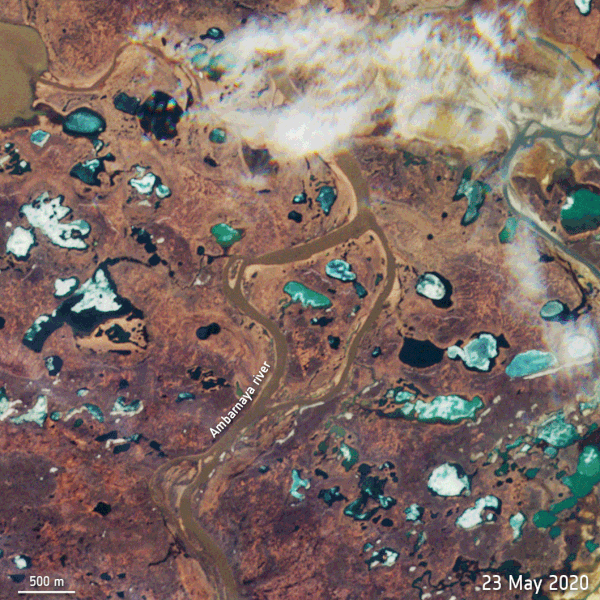As if this year already hadn’t piled up enough torments on living beings on the planet, the world woke up to one of the worst oil spills in history, near the Siberian city of Norilsk in Russia. The terrible news came, even as the world approached the World Environment Day. In an endless series of tragedies inflicting humans, animals, plants and other creatures that began this year with the devastating Australian bush fire and has been epitomised by the Covid-19 pandemic, the latest oil spill is a much avoidable addition. The accident poses a huge risk due to its supposed long term impacts on the environmentally critical Arctic region.
The state of emergency imposed by Russia after the oil spill, points to the seriousness. The spill happened when a fuel tank at a power plant near the city of Norilsk collapsed on May 29. The leaked oil drifted some 12km from the accident site. It is estimated that 20,000 tonnes of oil and lubricants were released which has turned the Ambarnaya river crimson and is expected to cause significant damage to the Arctic environment and ecosystem. The Ambarnaya River, which is the worst-affected by the spill, flows into the Arctic region. It feeds into Lake Pyasino, a major body of water and the source of the Pyasina River that is critically important to the entire Taimyr Peninsula having major ecological implications. It is perhaps the first such accident in the Arctic polar region and is believed to be the second largest in modern Russian history in terms of volume.
The state of emergency translates into greater and immediate focus with extra forces going to the area of the spill to assist with the clean-up operations. The company, along with the Russian Emergency Situations Ministry, has sent hundreds of workers to clean up the spill. A specialist clean-up team from Murmansk has been deployed to pump out the fuel. Besides, special containment booms are installed in the Ambarnaya River in an effort to prevent the spill from entering the nearby lake. But the scale of the spill and topography of the river has made the cleaning the area daunting. The tempting idea of burning the fuel is not being considered anymore, given the impact of heat on ice and ecosystem of the Arctic. Another impediment is the remoteness of the location and its swampy terrain where clean-up missions can be hampered by the lack of roads in the area.
Norilsk is a remote city with sparse population located 300 kilometres inside the Arctic Circle, where foreigners require special permission to visit. The city has also been in the limelight for its particularly bad pollution levels. Not quite coincidently, the plant is owned by a subsidiary of Norilsk Nickel, which is the world’s leading nickel and palladium producer. The secrecy around the city, its lowering environment standards and the presence of one of the largest global production chains point to a classic state-industrial complex, a younger cousin of the military-industrial complex. This is further corroborated by the exceptionalism granted to the conglomerate in the past. This company was also responsible for an oil spillage in 2016 which turned a river red in Siberia and one of its plants has apparently discharged so much sulphur dioxide that it is a major cause of acid rain in the area.
Norilsk Nickel has defended by stating that the melting permafrost driven by climate change may have caused subsidence of the fuel tank. The incident repositions Arctic at the helm in the debate on global warming and its impact on the Arctic region. Environmental scientists have warned for years that climate change causing the Arctic to warm faster than other areas of the world poses a threat to infrastructure built on permafrost. Permafrost thawing across Siberia, linked to climate change, has caused widespread problems such as buckled roads, collapsed homes and disruptions to traditional herding and agriculture.
Part of the Russian ongoing investigation into the spill will focus on the melting of the permafrost as a reason behind the spill. A thorough investigation could indeed point to many other dangerous installations on territories exposed to permafrost melting. Global warming melts a lot of permafrost during this time of the year and as the process of melting has intensified over the years, it has meant potentially more area for oil and gas exploration as well as newer shipping routes. For Russia which dominates large parts of the Arctic and depends heavily on energy exports for revenue, these developments come with huge opportunities. The question is — at what cost? The coordinator of WWF Russia has warned that the oil spill in Norilsk may lead to catastrophic consequences and the repercussions will be seen in the years to come in the forms of dead fish, polluted plumage of birds and poisoned animals. The diesel fuel being lighter is likely to remain in the environment, and restoring the ecological balance in the affected bodies of water will take decades. Greenpeace has compared the spill to the much larger Exxon Valdez oil spill of 1989 off Alaska in terms of potential environmental damage.
The emerging energy geopolitics in the Arctic is perhaps the next great game between Russia, U.S., and more recently, even China. The Arctic region contains an estimated 13 percent of the world’s undiscovered oil reserves, about one third of which lies on U.S. Arctic territory. Besides energy, Arctic also has rare earth deposits that drives competition. In so far as strategic gains of the melting of ice in the Arctic is concerned, it is expected to lead to the availability of the Northern Sea Route and a Northwest Passage connecting Europe to North America and the North-Eastern part of Asia for a few months of a year. For the rest of the year, countries would deploy ice-breakers in the region in order to keep the sea routes open.
The 1989 Exxon Valdez oil spill off the coast of Alaska releasing 39,000 tons of oil is a chilling parallel in history that led to the Oil Pollution Act 1990, which increased penalties for companies that spill oil into oceans and rivers. It remains to be seen whether the Norilsk spill leads to any legislative or administrative changes to prevent such future accidents in the critically sensitive Arctic region.
The views and opinions expressed in this article are those of the author.

The author is a Doctoral Research Scholar at the Centre for Russian and Central Asian Studies, School of International Studies, Jawaharlal Nehru University, New Delhi.


